2008 Philadelphia Eagles theme by Rainstorm81
Download: 2008PhiladelphiaEagles.p3t
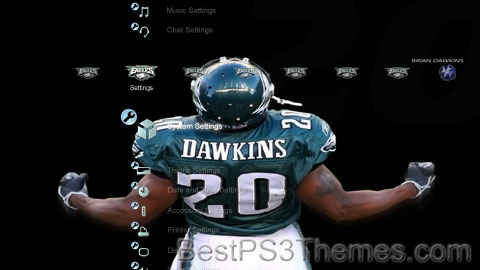
(16 backgrounds)
Redirect to:
This page is a redirect. The following categories are used to track and monitor this redirect:
|

The #1 spot for Playstation themes!
2008 Philadelphia Eagles theme by Rainstorm81
Download: 2008PhiladelphiaEagles.p3t

(16 backgrounds)
Redirect to:
This page is a redirect. The following categories are used to track and monitor this redirect:
|
Madden XX theme by DriveForSix
Download: MaddenXX.p3t
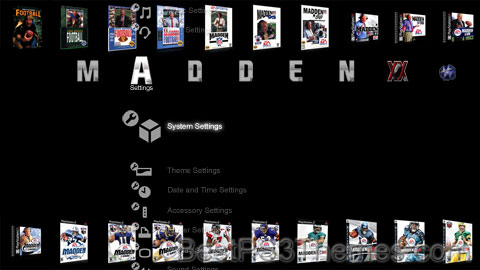
(5 backgrounds)
P3T Unpacker v0.12
Copyright (c) 2007. Anoop Menon
This program unpacks Playstation 3 Theme files (.p3t) so that you can touch-up an existing theme to your likings or use a certain wallpaper from it (as many themes have multiple). But remember, if you use content from another theme and release it, be sure to give credit!
Download for Windows: p3textractor.zip
Instructions:
Download p3textractor.zip from above. Extract the files to a folder with a program such as WinZip or WinRAR. Now there are multiple ways to extract the theme.
The first way is to simply open the p3t file with p3textractor.exe. If you don’t know how to do this, right click the p3t file and select Open With. Alternatively, open the p3t file and it will ask you to select a program to open with. Click Browse and find p3textractor.exe from where you previously extracted it to. It will open CMD and extract the theme to extracted.[filename]. After that, all you need to do for any future p3t files is open them and it will extract.
The second way is very simple. Just drag the p3t file to p3textractor.exe. It will open CMD and extract the theme to extracted.[filename].
For the third way, first put the p3t file you want to extract into the same folder as p3textractor.exe. Open CMD and browse to the folder with p3extractor.exe. Enter the following:
p3textractor filename.p3t [destination path]Replace filename with the name of the p3t file, and replace [destination path] with the name of the folder you want the files to be extracted to. A destination path is not required. By default it will extract to extracted.filename.
2008 Dallas Cowboys theme by Rainstorm81
Download: 2008DallasCowboys.p3t
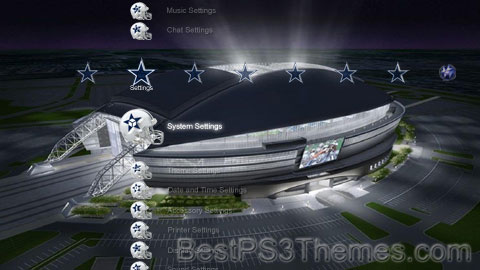
(16 backgrounds)
Redirect to:
This page is a redirect. The following categories are used to track and monitor this redirect:
|
Tennis theme by Rasenki
Download: Tennis.p3t
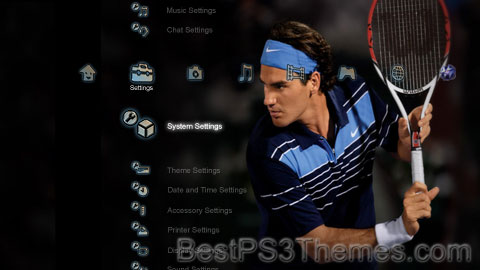
(9 backgrounds)
 French singles player Guillaume Rufin serves to Czech player Tomáš Berdych in a tennis match at the 2013 Australian Open | |
| Highest governing body | International Tennis Federation |
|---|---|
| First played | 19th century, Birmingham, England, United Kingdom |
| Characteristics | |
| Contact | No |
| Team members | Singles or doubles |
| Mixed-sex | Yes, separate tours and mixed doubles |
| Type | Outdoor or indoor |
| Equipment | Ball, racket, net |
| Venue | Tennis court |
| Glossary | Glossary of tennis terms |
| Presence | |
| Country or region | Worldwide |
| Olympic | Part of Summer Olympic programme from 1896 to 1924 Demonstration sport in the 1968 and 1984 Summer Olympics Part of Summer Olympic programme since 1988 |
| Paralympic | Part of Summer Paralympic programme since 1992 |
Tennis is a racket sport that is played either individually against a single opponent (singles) or between two teams of two players each (doubles). Each player uses a tennis racket that is strung with cord to strike a hollow rubber ball covered with felt over or around a net and into the opponent's court. The object of the game is to manoeuvre the ball in such a way that the opponent is not able to play a valid return. The player who is unable to return the ball validly will not gain a point, while the opposite player will.[1][2]
Tennis is an Olympic sport and is played at all levels of society and at all ages. The sport can be played by anyone who can hold a racket, including wheelchair users. The original forms of tennis developed in France during the late Middle Ages.[3] The modern form of tennis originated in Birmingham, England, in the late 19th century as lawn tennis.[4] It had close connections both to various field (lawn) games such as croquet and bowls as well as to the older racket sport today called real tennis.[5]
The rules of modern tennis have changed little since the 1890s. Two exceptions are that until 1961 the server had to keep one foot on the ground at all times,[6][7] and the adoption of the tiebreak in the 1970s.[8] A recent addition to professional tennis has been the adoption of electronic review technology coupled with a point-challenge system, which allows a player to contest the line call of a point, a system known as Hawk-Eye.[9][10]
Tennis is played by millions of recreational players and is a popular worldwide spectator sport.[11] The four Grand Slam tournaments (also referred to as the majors) are especially popular: the Australian Open, played on hardcourts; the French Open, played on red clay courts; Wimbledon, played on grass courts; and the US Open, also played on hardcourts.[12]
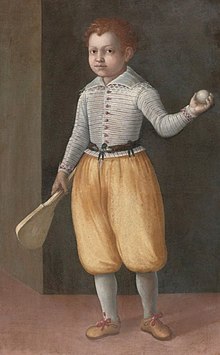

Historians believe that the game's ancient origin lay in 12th-century northern France, where a ball was struck with the palm of the hand.[13] Louis X of France was a keen player of jeu de paume ("game of the palm"), which evolved into real tennis, and became notable as the first person to construct indoor tennis courts in the modern style. Louis was unhappy with playing tennis outdoors and accordingly had indoor, enclosed courts made in Paris "around the end of the 13th century".[14] In due course this design spread across royal palaces all over Europe.[14] In June 1316 at Vincennes, Val-de-Marne, and following a particularly exhausting game, Louis drank a large quantity of cooled wine and subsequently died of either pneumonia or pleurisy, although there was also suspicion of poisoning.[15] Because of the contemporary accounts of his death, Louis X is history's first tennis player known by name.[15] Another of the early enthusiasts of the game was King Charles V of France, who had a court set up at the Louvre Palace.[16]
It was not until the 16th century that rackets came into use and the game began to be called "tennis", from the French term tenez, which can be translated as "hold!", "receive!" or "take!", an interjection used as a call from the server to his opponent.[17] It was popular in England and France, although the game was only played indoors, where the ball could be hit off the wall. Henry VIII of England was a big fan of this game, which is now known as real tennis.[18]
An epitaph in St Michael's Church, Coventry, written c. 1705, read, in part:[19]
Here lyes an old toss'd Tennis Ball:
Was racketted, from spring to fall,
With so much heat and so much hast,
Time's arm for shame grew tyred at last.
During the 18th and early 19th centuries, as real tennis declined, new racket sports emerged in England.[20]
The invention of the first lawn mower in Britain in 1830 is believed to have been a catalyst for the preparation of modern-style grass courts, sporting ovals, playing fields, pitches, greens, etc. This in turn led to the codification of modern rules for many sports, including lawn tennis, most football codes, lawn bowls and others.[21]
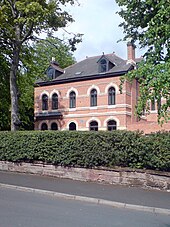
Between 1859 and 1865, Harry Gem, a solicitor, and his friend Augurio Perera developed a game that combined elements of racquets and the Basque ball game pelota, which they played on Perera's croquet lawn in Birmingham, England.[22][23] In 1872, along with two local doctors, they founded the world's first tennis club on Avenue Road, Leamington Spa.[24] This is where "lawn tennis" was used as the name of an activity by a club for the first time.
In Tennis: A Cultural History, Heiner Gillmeister reveals that on 8 December 1874, British army officer Walter Clopton Wingfield wrote to Harry Gem, commenting that he (Wingfield) had been experimenting with his version of lawn tennis "for a year and a half".[25] In December 1873, Wingfield designed and patented a game which he called sphairistikè (Greek: σφαιριστική, meaning "ball-playing"), and which was soon known simply as "sticky" – for the amusement of guests at a garden party on his friend's estate of Nantclwyd Hall, in Llanelidan, Wales.[26] According to R. D. C. Evans, turfgrass agronomist, "Sports historians all agree that [Wingfield] deserves much of the credit for the development of modern tennis."[20][27] According to Honor Godfrey, museum curator at Wimbledon, Wingfield "popularized this game enormously. He produced a boxed set which included a net, poles, rackets, balls for playing the game – and most importantly you had his rules. He was absolutely terrific at marketing and he sent his game all over the world. He had very good connections with the clergy, the law profession, and the aristocracy and he sent thousands of sets out in the first year or so, in 1874."[28] The world's oldest annual tennis tournament took place at Leamington Lawn Tennis Club in Birmingham in 1874.[29] This was three years before the All England Lawn Tennis and Croquet Club would hold its first championships at Wimbledon, in 1877. The first Championships culminated in a significant debate on how to standardise the rules.[28]
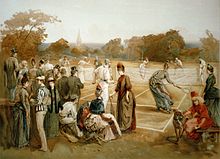
In the United States in 1874, Mary Ewing Outerbridge, a young socialite, returned from Bermuda with a sphairistikè set. She became fascinated by the game of tennis after watching British army officers play.[30] She laid out a tennis court at the Staten Island Cricket Club at Camp Washington, Tompkinsville, Staten Island, New York. The first American National championship was played there in September 1880. An Englishman named O.E. Woodhouse won the singles title, and a silver cup worth $100, by defeating Canadian I. F. Hellmuth.[31] There was also a doubles match which was won by a local pair. There were different rules at each club. The ball in Boston was larger than the one normally used in New York.
On 21 May 1881, the oldest nationwide tennis organization in the world[32] was formed, the United States National Lawn Tennis Association (now the United States Tennis Association) in order to standardize the rules and organize competitions.[33] The US National Men's Singles Championship, now the US Open, was first held in 1881 at the Newport Casino, Newport, Rhode Island.[34] The US National Women's Singles Championships were first held in 1887 in Philadelphia.[35]

Tennis also became popular in France, where the French Championships date to 1891, although until 1925 they were open only to tennis players who were members of French clubs.[36] Thus, Wimbledon, the US Open, the French Open and the Australian Open (dating to 1905) became and have remained the most prestigious events in tennis.[37][38] Together, these four events are called the Majors or Slams (a term borrowed from bridge rather than baseball).[39]
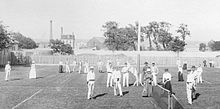
In 1913, the International Lawn Tennis Federation (ILTF), now the International Tennis Federation (ITF), was founded and established three official tournaments as the major championships of the day. The World Grass Court Championships were awarded to Great Britain. The World Hard Court Championships were awarded to France; the term "hard court" was used for clay courts at the time. Some tournaments were held in Belgium instead. And the World Covered Court Championships for indoor courts were awarded annually; Sweden, France, Great Britain, Denmark, Switzerland and Spain each hosted the tournament.[40] At a meeting held on 16 March 1923 in Paris, the title "World Championship" was dropped and a new category of "Official Championship" was created for events in Great Britain, France, the US and Australia [41] – today's Grand Slam events.[40][42] The impact on the four recipient nations to replace the "world championships" with "official championships" was simple in a general sense: each became a major nation of the federation with enhanced voting power, and each now operated a major event.[40]
The comprehensive rules promulgated in 1924 by the ILTF have remained largely stable in the ensuing 80 years, the one major change being the addition of the tiebreak system designed by Jimmy Van Alen.[43] That same year, tennis withdrew from the Olympics after the 1924 Games, but returned 60 years later as a 21-and-under demonstration event in 1984. This reinstatement was credited by the efforts of then ITF president Philippe Chatrier, ITF general secretary David Gray and ITF vice president Pablo Llorens, with support from International Olympic Committee president Juan Antonio Samaranch. The success of the event was overwhelming, and the IOC decided to reintroduce tennis as a full-medal sport at Seoul in 1988.[44][45]

The Davis Cup, an annual competition between men's national teams, dates to 1900.[46] The analogous competition for women's national teams, the Fed Cup, was founded as the Federation Cup in 1963 to celebrate the 50th anniversary of the founding of the ITF.[47]
In 1926, promoter C. C. Pyle established the first professional tennis tour with a group of American and French tennis players playing exhibition matches to paying audiences.[38][48] The most notable of these early professionals were the American Vinnie Richards and the Frenchwoman Suzanne Lenglen.[38][49] Players turned pro would no longer be permitted to compete in the major (amateur) tournaments.[38]
In 1968, commercial pressures and rumours of some amateurs taking money under the table led to the abandonment of this distinction, inaugurating the Open Era, in which all players could compete in all tournaments, and top players were able to make their living from tennis.[50] With the beginning of the Open Era, the establishment of an international professional tennis circuit, and revenues from the sale of television rights, tennis's popularity has spread worldwide, and the sport has shed its middle-class English-speaking image[51] (although it is acknowledged that this stereotype still exists).[51][52]
In 1954, Van Alen founded the International Tennis Hall of Fame, a nonprofit museum in Newport, Rhode Island.[53] The building contains a large collection of tennis memorabilia as well as a hall of fame honouring prominent members and tennis players from all over the world.[54]
Part of the appeal of tennis stems from the simplicity of equipment required for play. Beginners need only a racket and balls.[1]


The components of a tennis racket include a handle, known as the grip, connected to a neck which joins a roughly elliptical frame that holds a matrix of tightly pulled strings. For the first 100 years of the modern game, rackets were made of wood and of standard size, and strings were of animal gut. Laminated wood construction yielded more strength in rackets used through most of the 20th century until first metal and then composites of carbon graphite, ceramics, and lighter metals such as titanium were introduced. These stronger materials enabled the production of oversized rackets that yielded yet more power. Meanwhile, technology led to the use of synthetic strings that match the feel of gut yet with added durability.
Under modern rules of tennis, the rackets must adhere to the following guidelines;[55]
The rules regarding rackets have changed over time, as material and engineering advances have been made. For example, the maximum length of the frame had been 32 inches (81 cm) until 1997, when it was shortened to 29 inches (74 cm).[56]
Many companies manufacture and distribute tennis rackets. Wilson, Head and Babolat are three of the most commonly used brands; however, many more companies exist.[57] The same companies sponsor players to use these rackets in the hopes that the company name will become better known by the public.
There are multiple types of tennis strings, including natural gut and synthetic stings made from materials such as nylon, kevlar, or polyester.[58]

The first type of tennis strings available were natural gut strings, introduced by Babolat. They were the only type used until synthetic strings were introduced in the 1950s. Natural gut strings are still used frequently by players such as Roger Federer. They are made from cow intestines, and provide increased power, and are easier on the arm than most strings.[59]
Most synthetic strings are made from monofilament or multifiliament nylon strings. Monofilament strings are cheap to buy, and are used widely by many recreational level players for their all round performance, while multifilament strings are created to mimic natural gut more closely by weaving together fibres, but are generally more expensive than their monofilament counterparts.[58] Polyester strings allow for more spin on the ball than any other string, due to their firm strings, while keeping control of the ball, and this is why many players use them, especially higher player ones.[60] Kevlar tennis strings are highly durable, and are mostly used by players that frequently break strings, because they maintain tension well, but these strings can be stiff on the arm.[61]
Hybrid stringing is when a tennis racket is strung with two different strings for the mains (the vertical strings) and the crosses (the horizontal strings). This is most commonly done with two different strings that are made of different materials, but can also be done with two different types of the same string. A notable example of a player using hybrid strings is Roger Federer, using natural gut strings in his mains and polyester strings in his crosses.[62]

Tennis balls were originally made of cloth strips stitched together with thread and stuffed with feathers.[63] Modern tennis balls are made of hollow vulcanized rubber with a felt coating. Traditionally white, the predominant colour was gradually changed to optic yellow in the latter part of the 20th century to allow for improved visibility. Tennis balls must conform to certain criteria for size, weight, deformation, and bounce to be approved for regulation play. The International Tennis Federation (ITF) defines the official diameter as 65.41–68.58 mm (2.575–2.700 in). Balls must weigh between 56.0 and 59.4 g (1.98 and 2.10 oz).[64] Tennis balls were traditionally manufactured in the United States and Europe. Although the process of producing the balls has remained virtually unchanged for the past 100 years, the majority of manufacturing now takes place in the Far East. The relocation is due to cheaper labour costs and materials in the region.[65] Tournaments that are played under the ITF Rules of Tennis must use balls that are approved by the International Tennis Federation (ITF) and be named on the official ITF list of approved tennis balls.[66]
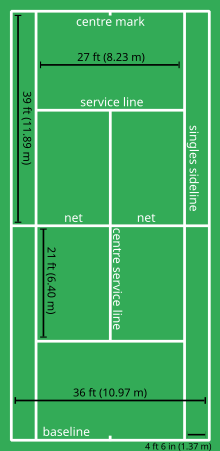
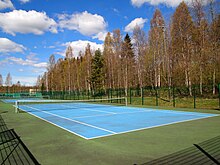
Tennis is played on a rectangular, flat surface. The court is 78 feet (23.77 m) long, and 27 feet (8.2 m) wide for singles matches and 36 ft (11 m) for doubles matches.[67] Additional clear space around the court is required in order for players to reach overrun balls. A net is stretched across the full width of the court, parallel with the baselines, dividing it into two equal ends. It is held up by either a cord or metal cable of diameter no greater than 0.8 cm (1⁄3 in).[66] The net is 3 feet 6 inches (1.07 m) high at the posts and 3 feet (0.91 m) high in the centre.[67] The net posts are 3 feet (0.91 m) outside the doubles court on each side or, for a singles net, 3 feet (0.91 m) outside the singles court on each side.
The modern tennis court owes its design to Major Walter Clopton Wingfield. In 1873, Wingfield patented a court much the same as the current one for his stické tennis (sphairistike). This template was modified in 1875 to the court design that exists today, with markings similar to Wingfield's version, but with the hourglass shape of his court changed to a rectangle.[68]
Tennis is unusual in that it is played on a variety of surfaces.[69] Grass, clay, and hard courts of concrete or asphalt topped with acrylic are the most common. Occasionally carpet is used for indoor play, with hardwood flooring having been historically used. Artificial turf courts can also be found.
The lines that delineate the width of the court are called the baseline (farthest back) and the service line (middle of the court). The short mark in the centre of each baseline is referred to as either the hash mark or the centre mark. The outermost lines that make up the length are called the doubles sidelines; they are the boundaries for doubles matches. The lines to the inside of the doubles sidelines are the singles sidelines, and are the boundaries in singles play. The area between a doubles sideline and the nearest singles sideline is called the doubles alley, playable in doubles play. The line that runs across the centre of a player's side of the court is called the service line because the serve must be delivered into the area between the service line and the net on the receiving side. Despite its name, this is not where a player legally stands when making a serve.[70]
The line dividing the service line in two is called the centre line or centre service line. The boxes this centre line creates are called the service boxes; depending on a player's position, they have to hit the ball into one of these when serving.[71] A ball is out only if none of it has hit the area inside the lines, or the line, upon its first bounce. All lines are required to be between 1 and 2 inches (25 and 51 mm) in width, with the exception of the baseline which can be up to 4 inches (100 mm) wide, although in practice it is often the same width as the others.[70]
WWE Theme – Diva Edition theme by OPTICS
Download: WWEDivaEdition.p3t

(16 backgrounds)
P3T Unpacker v0.12
Copyright (c) 2007. Anoop Menon
This program unpacks Playstation 3 Theme files (.p3t) so that you can touch-up an existing theme to your likings or use a certain wallpaper from it (as many themes have multiple). But remember, if you use content from another theme and release it, be sure to give credit!
Download for Windows: p3textractor.zip
Instructions:
Download p3textractor.zip from above. Extract the files to a folder with a program such as WinZip or WinRAR. Now there are multiple ways to extract the theme.
The first way is to simply open the p3t file with p3textractor.exe. If you don’t know how to do this, right click the p3t file and select Open With. Alternatively, open the p3t file and it will ask you to select a program to open with. Click Browse and find p3textractor.exe from where you previously extracted it to. It will open CMD and extract the theme to extracted.[filename]. After that, all you need to do for any future p3t files is open them and it will extract.
The second way is very simple. Just drag the p3t file to p3textractor.exe. It will open CMD and extract the theme to extracted.[filename].
For the third way, first put the p3t file you want to extract into the same folder as p3textractor.exe. Open CMD and browse to the folder with p3extractor.exe. Enter the following:
p3textractor filename.p3t [destination path]Replace filename with the name of the p3t file, and replace [destination path] with the name of the folder you want the files to be extracted to. A destination path is not required. By default it will extract to extracted.filename.
Alabama Crimson Tide theme by RollTide
Download: AlabamaCrimsonTide.p3t
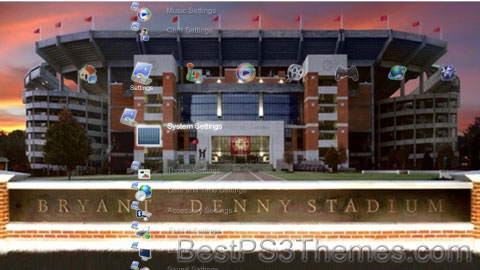
(3 backgrounds)
| Alabama Crimson Tide | |
|---|---|
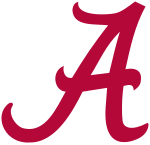 | |
| University | University of Alabama |
| Conference | SEC (primary) Big 12 (rowing)[A 1] |
| NCAA | Division I (FBS) |
| Athletic director | Greg Byrne |
| Location | Tuscaloosa, Alabama |
| Varsity teams | 21 |
| Football stadium | Bryant–Denny Stadium |
| Basketball arena | Coleman Coliseum |
| Baseball stadium | Sewell–Thomas Stadium |
| Softball stadium | Rhoads Stadium |
| Soccer stadium | Alabama Soccer Stadium |
| Aquatics center | Alabama Aquatics Center |
| Rowing venue | Black Warrior River |
| Tennis venue | Alabama Tennis Stadium |
| Outdoor track and field venue | Bailey Track Stadium |
| Other venues |
|
| Mascot | Big Al |
| Nickname | Crimson Tide |
| Fight song | Yea Alabama |
| Cheer |
|
| Colors | Crimson and white[2] |
| Website | www |
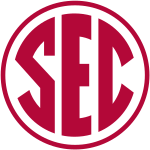
The Alabama Crimson Tide refers to the intercollegiate athletic varsity teams that represent the University of Alabama, located in Tuscaloosa. The Crimson Tide teams compete in the National Collegiate Athletic Association's Division I as a member of the Southeastern Conference (SEC) (with the exception of rowing, which competes in the Big 12 Conference). The Spirit Squads compete in the UCA and UDA College National Championships.
Athletics facilities on the campus include the 100,077-seat Bryant–Denny Stadium, named after football coach Paul "Bear" Bryant and former University President George Denny, 15,316-seat Coleman Coliseum, Foster Auditorium, Sewell–Thomas Stadium, the Alabama Soccer Stadium, the Sam Bailey Track Stadium, the Ol' Colony Golf Complex, the Alabama Aquatic Center, and the Alabama Tennis Stadium.
| Men's sports | Women's sports |
|---|---|
| Baseball | Basketball |
| Basketball | Cross country |
| Cross country | Golf |
| Football | Gymnastics |
| Golf | Rowing |
| Swimming & diving | Soccer |
| Tennis | Softball |
| Track & field† | Swimming & diving |
| Tennis | |
| Track & field† | |
| Volleyball | |
| † – Track and field includes both indoor and outdoor. | |
University of Alabama law student William G. Little learned how to play American football while attending school in Andover, Massachusetts and began teaching the sport to fellow Alabama students in early 1892.[3][4] Later in the year, the school formed an official team of 19 players, with Little as captain and E. B. Beaumont as head coach. Early newspaper accounts of Alabama football simply listed the team as the "varsity" or the "Crimson White", after the school colors. Headline writers then made popular the nickname "The Thin Red Line". It was not until 1907 that the name "Crimson Tide" was used to describe Alabama. The name was supposedly first used by Hugh Roberts, former sports editor of the Birmingham Age-Herald. Roberts coined the nickname to describe the 1907 Alabama–Auburn game, played in a sea of mud. Although Auburn was favored to win, Alabama played well in the red mud and held Auburn to a 6–6 tie.
Since then, the program has won 28 Southeastern Conference (SEC) championships and claimed 18 national championships. These include, for years prior to consensus selections, five titles from NCAA-recognized "major selectors" bestowed in 1934 and 1941, and retrospectively for 1925, 1926, and 1930. Alabama was also retrospectively selected as national champion for 1945, 1966, and 1977, as well as at the end of the 1975 college football season by the Matthews, Congrove, Colley Matrix, and Dunkel Systems,[5] but these five are not claimed by the university.[6][7] In January 2012, Alabama defeated No. 1 LSU 21–0 to take the BCS national title. In January 2013, Alabama defeated the Notre Dame Fighting Irish 42–14 for its 15th national championship.[8] In January 2016, Alabama defeated the Clemson Tigers 45–40 to claim its 16th national championship. On January 8, 2018, Alabama defeated the Georgia Bulldogs 26–23 to take the team's 17th national championship.[9] On January 11, 2021, Alabama defeated the Ohio State Buckeyes 52-24 for its 18th national championship.
The team has also made 65 bowl appearances throughout its history (an NCAA record), beginning with the 1926 Rose Bowl. Alabama's most recent bowl appearance was at the 2020 Citrus Bowl. Alabama has a 39–26–3 bowl game record. Since 1913, Alabama has had 98 players selected as first team All-Americans, with 29 of them being consensus selections. In 2009, Alabama also recorded their first Heisman Trophy winner, Mark Ingram II, in the closest Heisman Trophy race.[10] In 2015, Alabama had its second Heisman Trophy winner in Derrick Henry. In 2020, wide receiver DeVonta Smith became the program's third Heisman Trophy winner. This reoccurred in 2022 with Bryce Young.
Alabama's men's basketball program has numerous SEC Championships and players becoming NBA stars and international professional players. In the conference, it trails only Kentucky in basketball wins, SEC tournament titles, and SEC regular season conference titles. The men's basketball program rose to a No. 1 national ranking briefly in 2002. The Crimson Tide became a regular conference basketball contender much as it was in the 1980s under the direction of Coach Wimp Sanderson. Under head coach and former point guard Mark Gottfried, the Tide advanced to postseason play for six consecutive years, culminating with the team's advancement into the Elite Eight of the NCAA tournament for the first time in school history in 2004, where the team lost to eventual champion Connecticut in the Phoenix regional final.
In January 2009, Head Coach Mark Gottfried resigned after eleven years at Alabama. Soon afterwards Anthony Grant was hired as the new head coach. Under his watch the Crimson Tide battled through a tough first year, finishing 17–15 and achieving a top-10 ranking in points allowed on defense. Grant's second season with the Tide resulted in the SEC Western Division Championship, finishing 12–4 in the SEC and an overall record of 25–12. They entered the 2011 NIT Tournament with a No. 1 seed and made it to the NIT Championship Game and finished as the runner-up. The Crimson Tide was unbeaten at home with a perfect 19–0 season, a school record. In 2012 the Crimson Tide was a participant in the NCAA tournament and finished its season with a 21–12 record. Former Dallas Mavericks and New Jersey/Brooklyn Nets coach Avery Johnson became the Alabama Head Coach on April 5, 2015. Nate Oats became head coach on March 27, 2019. Since then Nate Oats has been 92-41 with the Tide. In 2023 they went all the way to the tournament as the no.1 seed for the first time in program history. They lost to the San Diego State in the Sweet Sixteen.
Alabama's women's basketball team competes in Coleman Coliseum and had previously played in Foster Auditorium. The team played its first game in 1974 and has since been a varsity sport. The team has had nine head coaches, including Rick Moody, who guided the club to the 1994 NCAA Women's Final Four. Kristy Curry was named head coach on May 11, 2013, replacing Wendell Hudson.
The Crimson Tide has appeared in ten post-season Tournaments for the NCAA Women's Division I Basketball Championship, including an eight-year streak of consecutive appearances in the tournament stretching from 1992 to 1999. In ten NCAA tournament appearances, Alabama has advanced to the "Sweet Sixteen" six times and the "Elite Eight" and the "Final Four" in 1994. The most successful season was 1996–1997 when the Tide finished second in the Southeastern Conference (10–2 record) and had a mid-season national ranking of No. 2 in polls by the AP and USA Today (November 12, 1996); they finished with a 25–7 overall record. The University of Alabama Women's Basketball program shares the national record with Duke University for the most total points for both teams when Alabama defeated Duke 121–120 (in four overtimes) in 1995 in the NCAA tournament, a game that ESPN has declared as one of the best all-time women's basketball tournament games.[11] Seven former players for the University of Alabama have made rosters of teams of the WNBA. Alabama has had an active player in the WNBA through every year of its existence. The current head coach for the Crimson Tide is Kristy Curry. The team played its first season of 1974–75 in Foster Auditorium, but moved to what is now Coleman Coliseum the following season. After Foster Auditorium was extensively renovated in a project that began in 2009, the Tide returned to their original home on February 13, 2011.
Alabama has baseball. The Crimson Tide is second to LSU for the most SEC titles with 14 (including 13 regular season titles and one tournament title that was won in 1983, during an era in which the tournament decided the overall SEC title). Alabama is also second to the Tigers with seven SEC Tournament championships, including the 1983 one that decided the overall SEC title. Tide baseball teams have participated in the NCAA College World Series five times (1950, 1983, 1996, 1997, 1999), finishing second in 1983 (to Texas) and 1997 (to LSU). Home games are played at Sewell–Thomas Stadium, known as "The Joe" to Crimson Tide fans. The baseball team is currently coached by head coach Brad Bohannon.
The Alabama softball team was started in 1997. They are currently coached by head coach Patrick Murphy and assistant coaches Alyson Habetz and Stephanie VanBrakle. They have won six Southeastern Conference championships (two regular seasons and four tournaments), made 18 consecutive NCAA tournaments (every year since 1999) and have advanced to the Women's College World Series eight times, including back-to-back third-place finishes in the 2008 and 2009 series. On June 7, 2012, Alabama became the first team in SEC history to win the WCWS Championship defeating Oklahoma in three games. The team's current overall record stands at 708–224 (.759). Alabama has won the SEC softball tournament five times (1998, 2003, 2005, 2010 and 2012).
Alabama's men's and women's golf teams have become two of the top programs in the nation since head coaches Jay Seawell (men) and Mic Potter (women) took over in the 2002 and 2006 respectively.[citation needed] They have combined to make the NCAA tournament 13 out of 14 chances since they arrived, and have each led their teams to a Southeastern Conference Championship. Overall the Crimson Tide golf teams have combined to make the NCAA tournament 31 times, won the SEC Championship four times, and have had over 30 players honored as All-Americans. The men's golf program finished sixth in the nation in 2007, while being consistently ranked in the top three in the 2007–08 season. The home course for the Tide has been the Ol' Colony Golf Complex since 2005.[citation needed]
In 2012, the Crimson Tide has two of the best teams in the country with the women ranked No. 1 and men ranked No. 4 by Golf Week.[12] The women's golf team won their first national title in 2012 while the men finished as the national runner-up.[13] In 1941, Eleanor Dudley won the inaugural women's individual intercollegiate golf championship (an event conducted by the Division of Girls' and Women's Sports (DGWS) — which later evolved into the AIAW championship in the 1970s).
On June 2, 2013, the Alabama men's golf team won their first NCAA national title after defeating Illinois in the title match.[14]
The women's gymnastics squad at The University of Alabama first competed in 1975. The squad did not have a winning season until the arrival of former coach Sarah Patterson in 1979. In the following 35 years under Patterson and her husband David, the squad won six NCAA national championships, seven SEC championships, 26 regional titles, and 248 All-American honors. It has placed in the top five at the NCAA Championships 25 of the past 29 years and won national championships six times: in 1988, 1991, 1996, 2002, and most recently won back to back titles in 2011 and 2012. Alabama has also won nine SEC Championships including 1988, 1990, 1995, 2000, 2003, 2009, 2011, 2014, and 2015. The gymnastics squad also hosts an annual fundraiser for breast cancer, where the crowd is encouraged to "Think Pink" and support the cause by turning out in pink clothing. As of the 2009 fundraiser, the effort had raised in excess of $750,000.[15]
Gymnastics meets have an average attendance of over 13,000 at Coleman Coliseum. Meets against the team's arch-rival, the University of Georgia Gymdogs, often sell out. Alabama holds seven of the eleven NCAA records for the largest gymnastics crowds of all time, including an attendance of 15,162 fans on January 20, 2006. Alabama's gymnastics team is led by head coach Dana Duckworth, a former Crimson Tide gymnast and two-time NCAA champion, and competes in Coleman Coliseum.
The Crimson Tide's men's track and field program has produced numerous individual national champions, including Calvin Smith, the former world record holder in the 100-meter dash, Jan Johnson (pole vault), Gary England (shot put), Jeff Woodard (high jump), William Wuycke (1000 yards and 1000 meters), Emmit King (100 m), Keith Talley (55 m and 100 m hurdles), Andrew Owusu (long jump), Miguel Pate (long jump and NCAA national record), Mats Nilsson, Tim Broe (3000 m steeplechase), David Kimani (3000 m indoor and 5000 m), Kirani James (400 m), Diondre Batson (Indoor 200 meters), Hayden Reed (Discus) and the 4 × 100 meter relay team of Richard Beattie, Brad McQuaig, Eduardo Nava, and Clive Wright, and the mile relay team of Joe Coombs, Darroll Gatson, Tony Husbands, and Ike Levin.
Individual national champions from the Crimson Tide women's track and field team have included Disa Gisladottir (high jump), Iris Gronfeldt (javelin), Lillie Leatherwood (400 m), Liz McColgan (née Lynch; mile), Pauline Davis-Thompson (200 m), Flora Hyacinth (triple jump), Beth Mallory (discus), Remona Burchell (indoor 60 m), and Quanesha Burks (long jump).
Coach Dan Waters is the head coach for both the men's and women's track and field program, assuming the position in 2012. The university hosts the Alabama Relays and the Crimson Classic annually, which brings many of the top programs in the country to compete at the Sam Bailey Track Stadium, built in 1975 with seating for 4,500 fans. A renovation project in 2012 created a facility that is among America's best.[16]
Women's soccer was a varsity sport from 1986 to 1988, and was revived in 1994. Former head coach Don Staley had been with the program since 1994, but stepped down at the end of the 2007 season. He was replaced with former Clemson University head coach Todd Bramble. The team has won the SEC West three times (1995, 97, 98) and participated in the NCAA Women's Soccer Championship in 1999 and 2011. In 2005, senior Libby Probst earned third team All-American honors and the SEC Scholar-Athlete of the Year award after breaking almost every major offensive record in her career at the Capstone. The team currently plays its home games at the Alabama Soccer Stadium. Wes Hart became the head coach in 2015.[17]
The Alabama women's volleyball is coached by Ed Allen, who was hired on January 10, 2011. The team has competed in the NCAA Women's Volleyball Championship in 2005, 2006, and 2007. The team won the SEC Western Division Championship in 2000 and 2004, and was the SEC Volleyball Tournament Runner-up in 2005. In 2000, the Alabama Volleyball team achieved the nation's best team-GPA among Division I Volleyball teams. Past coaches for Alabama Volleyball have included Stephanie Schleuder, Dorothy Franco-Reed, and Judy Green. The venue for the Crimson Tide's home volleyball games is Foster Auditorium.
Men's and women's tennis at the University of Alabama have built a tradition of excellence and enjoy competing in the Roberta Alison Baumgardner Indoor Tennis Facility, and the University of Alabama Tennis Stadium, which has won an award from USTA for being among the most excellent tennis facilities in the nation, and has been selected as the host site for regional tournaments by the NCAA in 2012 and 2013. In the 1960s, Roberta Alison became Alabama's first female athlete when she joined the men's team and occasionally played the No. 1 and No. 2 positions. She went on to win American Women's collegiate Championships in 1962 and 1963 for singles, and 1963 in doubles. Today the Alabama Tennis program hosts the Roberta Alison Fall Tennis Classic each year to honor her.
Alabama men's tennis began in 1949 with the coach, Lee Shapiro. Through the years, additional coaches have developed Alabama's program, including C. de la Manardiere (1951–1953, 1956); Rafael de Valle (1954–1955 and 1958–1960); Dr. Eugene Lambert (coach) in 1957; Jason Morton (1961–1964); Earl Baumgardner (1965–1966); Bill Mallory in 1967; Dale Anderson (1968–1969); Bill McClain (1970–1977); Armistead Neely (1978–1982); Tommy Wade (1983–1988); John Kreis (1989–1994); Joey Rive (1995–1997); Adam Steinberg (1998–2002); Billy Pate (2003–2012), and the current head coach, George Husack, 2013.
The Men's Tennis Team has been a participant in the NCAA tournament 17 times: 1989, 1990, 1993, 1996, 1997, 1998, 1999, 2001, 2002, 2003, 2004, 2006, 2007, 2008, 2009, 2010, and 2013, as well as having 33 singles qualifying and 17 doubles qualifying for the NCAA tournament. Alabama's All-Americans include Jeff Robinson (1976, 1977), Andy Solis (1984, 1985), Gregg Hahn (1985, 1986), John Stimpson (1990), Francisco Rodriquez (1998, 1999), Maxim Belski (2001), Clinton Ferriera (1986, 1989), Ellis Ferriera (1989, 1990, 1991), Rick Witsken (1991, 1993), and Juan Carlos Bianchi (1993). Additionally, Stephen Mitchell, among others, played professionally, and Konstantinos Efraimoglou was an Olympian in tennis in 1992. Ellis Ferreira became the champion at the 2000 Australian Open in men's doubles and 2001 Australian Open in mixed doubles. Davis Cup participants have included Juan Carlos Bianchi, Francisco Rodriguez, and Michael-Ray Pallares-González.
Alabama's women's tennis team began in 1975, although Roberta Alison competed individually through the men's team years earlier. Coaches for the Crimson Tide Women's tennis team include Jean Mills (1975–1978), Mark Heinrick (1979–1980), Lewis Lay in 1981, Peter Heffeman (1982–1984), Karin Gaiser (1985–1993), Jim Tressler (1994–1997), Michelle Morton in 1997, and the current coach, Jenny Mainz (1998–2013). Coach Jenny Mainz was named in 2013 as the National Coach of the Year after her team reached the Round of 16 and had a singles player and a doubles team to both reach the national semifinals.
All-Americans for the Crimson Tide women's tennis team include Titia Wilmink (1993), Marouschka van Dijk (1993), Baili Camino (1997), Robin Stephenson (2005), Alexa Guarachi (2013), Mary Anne Macfarlane (2012, 2013). The Crimson Tide women's team has sent 17 qualifiers for NCAA Singles Tournaments and twelve for the Doubles Tournaments as of 2013[update]. The Tide competed as a team in the NCAA tournaments of 1993, 1997, 2001, 2002, 2003, 2004, 2005, 2006, 2009, 2011, 2012, and 2013. The 2013 team produced the best results in program history, ending the season with a Sweet Sixteen appearance. Alabama was the winner of the NCAA Women's Doubles National Championship in 2014 and 2015 with the team of Erin Routliffe and Maya Jansen.
Women's rowing is the most recent addition to Alabama's list of varsity athletics. Mal Moore announced the addition of Alabama's 21st varsity sport in October 2005. The women's rowing team became the newest varsity sport at The University of Alabama in Fall 2006. The team was added due to the NCAA's Title IX and allows for 20 full scholarships.[18] Taking only girls who had previously rowed for the Alabama Crew Club (est. 1987) and other walk-ons, Head Coach Larry Davis built the program from the ground up. In the first year of competition (2006–2007), the Tide defeated the University of Cincinnati, Creighton University, and Murray State University and also won medals at the Head of the Chattahoochee and the Head of the South.
The second year (2007–2008) of competition surprised many as the Varsity eight went on to win silver medals at the prestigious
Dwight Howard theme by frankie Download: DwightHoward.p3t
Dwight David Howard II (born December 8, 1985) is an American professional basketball player for the Taiwan Mustangs of The Asian Tournament (TAT). He began his career in the National Basketball Association (NBA), where he was an NBA champion, eight-time All-Star, eight-time All-NBA Team honoree, five-time All-Defensive Team member, and three-time Defensive Player of the Year.
Howard, who plays center, spent his high school career at Southwest Atlanta Christian Academy. He chose to forgo college, entered the 2004 NBA draft, and was selected first overall by the Orlando Magic. Howard set numerous franchise and league records with the Magic. He led the team to the 2009 NBA Finals.
In 2012, after eight seasons with Orlando, Howard was traded to the Los Angeles Lakers, with whom he spent three separate one year-stints over the course of his career, winning the NBA Finals in 2020. He has also played for the Houston Rockets, the Atlanta Hawks, the Charlotte Hornets, the Washington Wizards, and the Philadelphia 76ers.
After playing with the Lakers in 2021–22, Howard moved overseas and signed with the Taiwanese-based Leopards. In his first season with the team, he was named a T1 All-Star.
Howard was born in Atlanta, to Dwight Sr. and Sheryl Howard, a family with strong athletic connections. His father is a Georgia State Trooper and is the athletic director at Southwest Atlanta Christian Academy, a private academy with one of the country's best high school basketball programs; his mother played on the inaugural women's basketball team at Morris Brown College.[1] Howard's mother had seven miscarriages before he was born.[2] A devout Christian since his youth, Howard became serious about basketball around the age of nine.[3][4] Despite his large frame, Howard was quick and versatile enough to play the guard position.[4] He attended Southwest Atlanta Christian Academy and played mostly as power forward, averaging 16.6 points, 13.4 rebounds and 6.3 blocks per game in 129 appearances.[1][4] As a senior, Howard led his team to a 31–2 record and the 2004 state title,[4][5] while averaging 25 points, 18 rebounds, 8.1 blocks and 3.5 assists per game.[4] The same year, he was widely recognized as the best American high school basketball player, and received the Naismith Prep Player of the Year Award, the Morgan Wootten High School Player of the Year Award, Gatorade National Player of the Year and the McDonald's National High School Player of the Year honor.[6] He was also co-MVP (with J. R. Smith) of the McDonald's All-American Game that year.[6] On January 31, 2012, Howard was honored as one of the 35 greatest McDonald's All-Americans.[7]
Following his high school successes, Howard chose to forego college and declared for the 2004 NBA draft—a decision partly inspired by his idol Kevin Garnett who had done the same in 1995—where the Orlando Magic selected him first overall over UConn junior Emeka Okafor.[1][4] He took the number 12 for his jersey, in part because it was the reverse of Garnett's 21 when he played for Minnesota.[8] Howard joined a depleted Magic squad that had finished with only 21 victories the previous season; further, the club had just lost perennial NBA All-Star Tracy McGrady.[4] Howard, however, made an immediate impact. He finished his rookie season with an average of 12 points and 10 rebounds,[9] setting several NBA records in the process. He became the youngest player in NBA history to average a double double in the regular season.[6] He also became the youngest player in NBA history to average at least 10 rebounds in a season and youngest NBA player ever to record at least 20 rebounds in a game.[6] Howard's importance to the Magic was highlighted when he became the first player in NBA history directly out of high school to start all 82 games during his rookie season.[6] For his efforts, he was selected to play in the 2005 NBA Rookie Challenge, and was unanimously selected to the All-Rookie Team.[6] He also finished third in the Rookie of the Year voting.[10]
Howard reported to camp for his second NBA season having added 20 pounds of muscle during the off-season.[4] Orlando coach Brian Hill—responsible for grooming former Magic superstar Shaquille O'Neal—decided that Howard should be converted into a full-fledged center.[4] Hill identified two areas where Howard needed to improve: his post-up game and his defense. He exerted extra pressure on Howard, saying that the Magic would need him to emerge as a force in the middle before the team had a chance at the playoffs.[4] On November 15, 2005, in a home game against the Charlotte Bobcats, Howard recorded 21 points and 20 rebounds, becoming the youngest player ever to score 20 or more points and gather 20 or more rebounds in the same game.[11] He was selected to play on the Sophomore Team in the 2006 Rookie Challenge during the All-Star break.[1] Overall, he averaged 15.8 points and 12.5 rebounds per game,[9] ranking second in the NBA in rebounds per game, offensive rebounds, and double-doubles and sixth in field goal percentage.[1] Despite Howard's improvement, the Magic finished the season with a 36–46 record and failed to qualify for the playoffs for the second consecutive season since Howard's arrival.[12]
In the 2006–07 season (and for the third consecutive season), Howard played in all 82 regular-season games.[9] On February 1, 2007, he received his first NBA All-Star selection as a reserve on the Eastern Conference squad for the 2007 NBA All-Star Game.[1] On February 9, he made a game-winning alley-oop off an inbound pass at the buzzer against the San Antonio Spurs.[13] Howard set a new career high with 35 points against the Philadelphia 76ers on April 14.[14] Under his leadership, the Magic qualified for the 2007 NBA Playoffs as the eighth seed in the Eastern Conference.[15] There, the Magic were swept by the Detroit Pistons in the first round.[16] For the season, Howard averaged 17.6 points and 12.3 rebounds per game, finishing first in the NBA in total rebounds, second in field goal percentage, and ninth in blocks. He was named to the All-NBA Third Team at the end of the 2006–07 campaign.[17]
Howard continued posting impressive numbers in the 2007–08 season and helped the Magic have their best season to date. Howard was named as a starter for the Eastern Conference All-Star team.[18][19] On February 16, 2008, he won the NBA Slam Dunk Contest by receiving 78% of the fan's votes via text messaging or online voting; in that contest, he performed a series of innovative dunks said to have rejuvenated the contest, including donning a Superman cape for one of the dunks.[20] Howard led the Magic to their first division title in 12 years and to the third seed for the 2008 NBA Playoffs.[19] In their first round match-up against the Toronto Raptors, Howard's dominance (three 20-point/20-rebound games) helped Orlando to prevail in five games.[21] Howard's series total of 91 rebounds was also greater than the total rebounds collected by the entire Toronto frontcourt.[22] In the second round against the Pistons, the Magic lost in five games.[23] For the season, Howard was named to the All-NBA First Team for the first time,[19] and was also named to the NBA All-Defensive Second Team.[24]
The 2008–09 season began well for Howard. Ten games into the season, the center was leading the league in blocks per game (4.2).[25] In December, Howard injured his left knee, which caused him to miss a game due to injury for the first time in his NBA career; previously, he had played in 351 consecutive games.[26] He garnered a record 3.1 million votes to earn the starting berth on the Eastern Conference team for the 2009 NBA All-Star Game.[27] Howard led Orlando to its second straight Southeast Division title[28] and to the third seed for the 2009 NBA Playoffs; the team finished the season with a 59–23 record.[29] In the first round of the playoffs against the 76ers, Howard recorded 24 points and 24 rebounds in Game 5 to give Orlando a 3–2 lead before the Magic closed out the series in six games. In the second round against the Boston Celtics, after the Magic blew a lead in Game 5 to fall behind 3–2 in the series, Howard publicly stated that he should have been given the ball more and questioned coach Stan Van Gundy's tactics. The Magic went on to defeat Boston to win the series and move on to the Eastern Conference Finals. There they, defeated the Cleveland Cavaliers 4–2. Howard had a playoff career-high 40 points to go with his 14 rebounds in the deciding Game 6, leading Orlando to the NBA Finals for the first time in 14 years.[30] In the NBA Finals, the Los Angeles Lakers took the first two home games, before a home win by the Magic brought the deficit to 2–1. In Game 4, despite Howard putting up 21 rebounds and a Finals record of 9 blocks in a game, the Magic lost in overtime.[31] The Lakers went on to clinch the series with a win in Game 5.[32] For the season, Howard became the youngest player ever to win the NBA Defensive Player of the Year Award.[8] He was also named to the NBA All-Defensive First Team,[33] and to the All-NBA First Team.[34]
In the 2009–10 season, the Magic got off to a strong start, winning 17 of their first 21 games and setting a franchise record. On January 21, 2010, Howard was named as the starting center for the East in the 2010 NBA All-Star Game.[35] The Magic completed the regular season with 59 wins and their third consecutive division title. The Magic's playoff run resulted another Eastern Conference Finals appearance, where they lost in six games to the Celtics. Howard won the Defensive Player of the Year Award for the second straight year.[36] He became the first player in NBA history to lead the league in blocks and rebounds in the same season twice—and for two years in a row.[36]
In the 2010–11 season, Howard posted career highs in points and field goal percentage. He became the first player in league history to win Defensive Player of the Year honors for three consecutive seasons. Howard led the league in double-doubles and also averaged 14.1 rebounds, 2.3 blocks and a career-high 1.3 steals this season.[37] He led the Magic to 52 wins, as they finished as the fourth seed in the Eastern Conference. They went on to lose to the Atlanta Hawks in the first round of 2011 NBA Playoffs.[38] He had a playoff career-high 46 points and 19 rebounds in Orlando's 103–93 loss to Atlanta in Game 1.[37] Howard led the NBA in technical fouls with 18 in the regular season, and received one-game suspensions after his 16th and 18th technicals.[39]
Due to a lockout, the 2011–12 regular season was shortened to 66 games. Not long after the lockout ended, Howard, who was eligible to become a free agent at the end of the season, demanded a trade to the New Jersey Nets, Los Angeles Lakers or Dallas Mavericks.[40] Howard stated that although his preference was to remain in Orlando, he did not feel the Magic organization was doing enough to build a championship contender.[41] He would later meet with Magic officials and agree to back off his trade demands, but stated that he also felt the team needed to make changes to the roster if they wanted to contend for a championship.[42]
On January 12, 2012, Howard attempted an NBA regular season record 39 free throws against the Golden State Warriors. Howard entered the game making 42 percent of his free throws for the season and just below 60 percent for his career. The Warriors hacked Howard intentionally throughout the game, and he broke Wilt Chamberlain's regular-season record of 34 set in 1962. Howard made 21 of the 39 attempts, finishing with 45 points and 23 rebounds in the Magic's 117–109 victory.[43] On January 24, 2012, Howard became the Magic's all-time scoring leader.[44]
On March 15, 2012, on the day of the trading deadline for the 2011–12 NBA season, Howard waived his right to opt out of his contract at the end of the season and committed to stay with the Magic through the 2012–13 season. He had previously asked to be traded to the New Jersey Nets. Had he not signed the amendment, the Magic were prepared to trade him to avoid losing him as a free agent.[45] On April 5, Van Gundy said that he had been informed by management that Howard wanted him fired. During the interview, the center walked up and hugged his coach, unaware that Van Gundy had confirmed a report that Howard denied.[46][47] Van Gundy was let go after the season.[48]
On April 19, 2012, Howard's agent said that Howard would undergo surgery to repair a herniated disk in his back and would miss the rest of the 2011–12 season, as well as the 2012 Summer Olympics in London.[49] During the offseason, Howard again requested a trade to the Nets, who had relocated to Brooklyn. He intended to become a free agent at the end of the 2012–13 season if he was not traded to Brooklyn.[50][51]
On August 10, 2012, Howard was traded from Orlando to the Los Angeles Lakers in a deal that also involved the Philadelphia 76ers and the Denver Nuggets. Howard took six months off from basketball after his April back surgery, and only had the combined four weeks of training camp and preseason to prepare for the season.[52][53] Still working himself into shape, Howard paced himself throughout the season on both offense and defense.[53] On January 4, 2013, Howard injured his right shoulder in the second half of the Lakers' 107–102 loss to the
Ohio State theme by Jay Bird Download: OhioState.p3t Redirect to:Dwight Howard
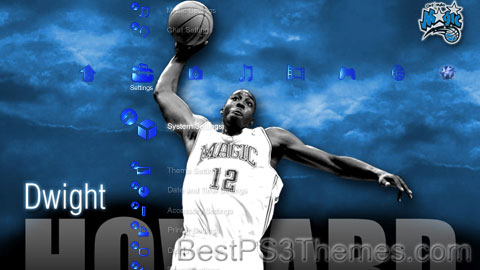
(15 backgrounds)
Early life[edit]
Professional career[edit]
Orlando Magic (2004–2012)[edit]
Early years (2004–2008)[edit]

Dominance and NBA Finals appearance (2008–2011)[edit]

Final season in Orlando (2011–2012)[edit]

Los Angeles Lakers (2012–2013)[edit]
Ohio State
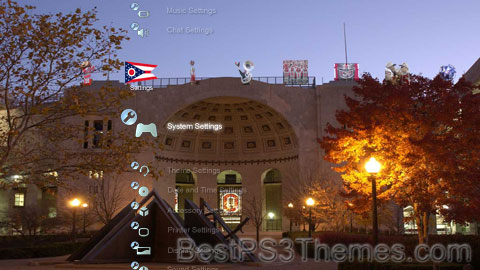
(5 backgrounds)